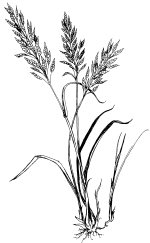
Cattle Grazing at Prairie Creek
Although cattle can be destructive, controlled grazing is a conservation and management technique used successfully in prairie ecosystems throughout the country and therefore is a future possibility for Prairie Creek.
There are five unique methods for controlled grazing (described below), some of which can be used effectively in prairie ecosystems.


Quote from the Minnesota DNR
"By reducing the height and density of grasses, conservation grazing creates room for dozens of wildflower species, especially shorter species such as pasque flower, prairie smoke, and bird's foot violet."
Five Methods of Controlled Grazing
1. First-Last Grazing: One group of livestock--usually with high and selective nutritional needs--is allowed to use certain areas first. A second group of livestock--usually with low and less selective nutritional needs--uses the same area.
2. Flash Grazing: A large concentration of cattle is allowed to graze in a very small area for a very short time. This area is given a long time to rejuvenate and recuperate.
3. Patch-Burn Grazing: Certain areas are burned to attract cattle.
4. Rotational Grazing: Certain areas are used for grazing while on others, forage grows. These areas are rotated periodically, allowing them to rejuvenate, get used, recuperate and then rejuvenate again.
5. Strip Grazing: Animals are placed within certain areas and a fence is placed around the animals and land.
Pros
1. Local farmers can cheaply feed their livestock premium, healthy food, thereby improving the quality of their cattle products.
2. Cattle can stimulate the growth of native plant species while inhibiting the growth of invasive species.
3. Cattles' eating patterns fosters wildlife diversity by creating a multitude of habitats concentrated in one area.
4. Livestock can be easily manipulated, unlike other regulatory methods such as fire.
5. In comparison to fire (currently used at Prairie Creek and other WMAs), cattle grazing can be more economically efficient.
6. Prairie sites can also benefit from the manure left by cattle as manure is an excellent source of free fertilizer.
Specifically, cattle tend to eat more in certain spots than in anothers, creating a variation of grass heights patterns. Also, cattle eat in unpredictable patterns condusive to wildlife habitats.
Cons
1. There needs to be easy access to cattle farms willing to lend the cattle for grazing.
2. Cattle produce large amounts of carbon dioxide that is harmful to the environment.
3. If not managed properly, cattle can over-graze the prairie.
4. At Prairie Creek, Craig Koester commented "the fences have not been maintained for a number of years [so] much of it would need to be replaced."
5. There would need to be sufficient sources of water, so the creation of a well would be another expense.
6. The recreational hunting currently allowed at Prairie Creek might be affected by the presence of cattle.
7. When transporting cattle to Prairie Creek, there would be a large risk of bringing in the seeds of invasive plant species.
Specifically, cattle grazing would have a negative short-term impact on hunting as the freshly grazed areas would become temporarily insufficient for wildlife. And the presence of the cattle might temporarily scare wild game, such as pheasants, away from the area.
Remaining Questions
1. What would be the costs of controlled grazing on Prairie Creek?
2. How would controlled grazing affect the land and ecosystems of Prairie Creek?
3. What would be the be the potential impacts on the community if Prairie Creek began using controlled grazing as a management strategy?



